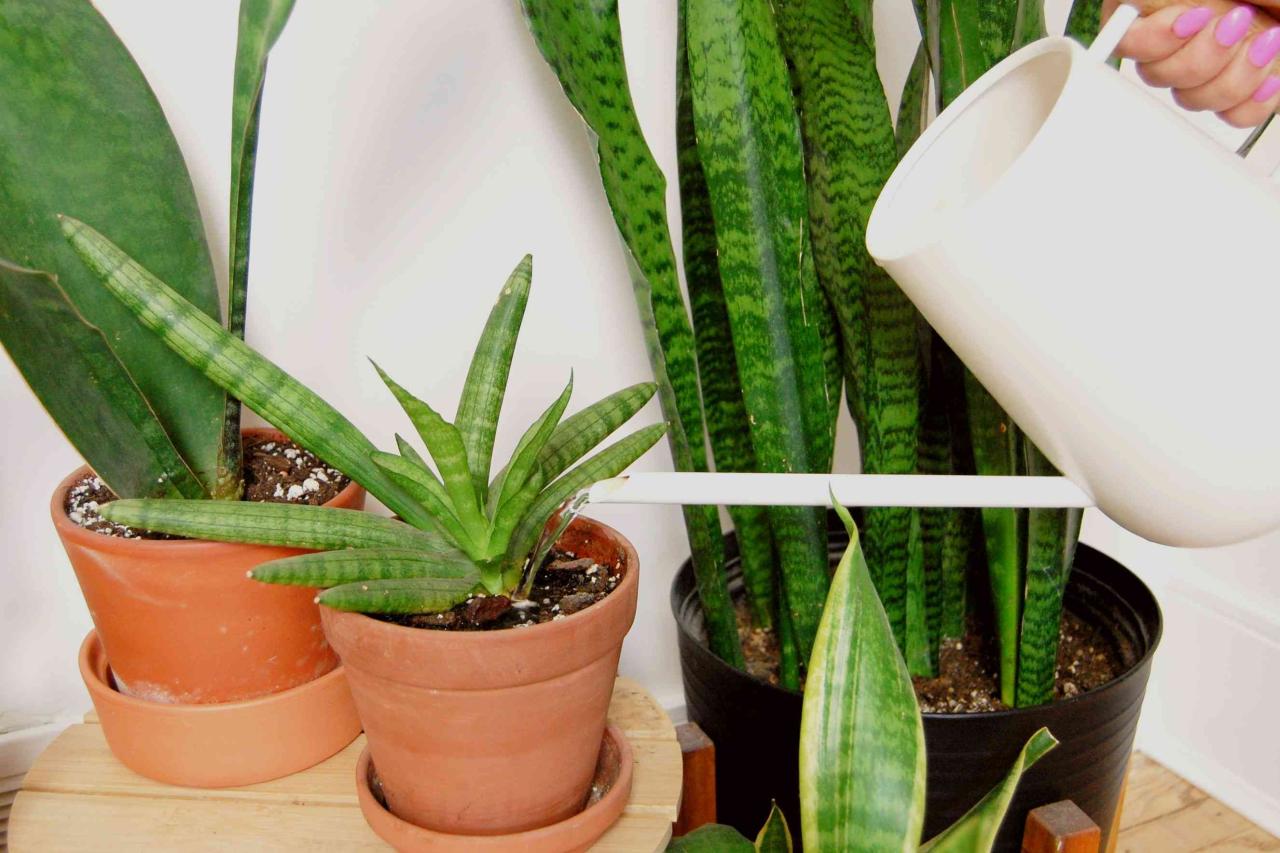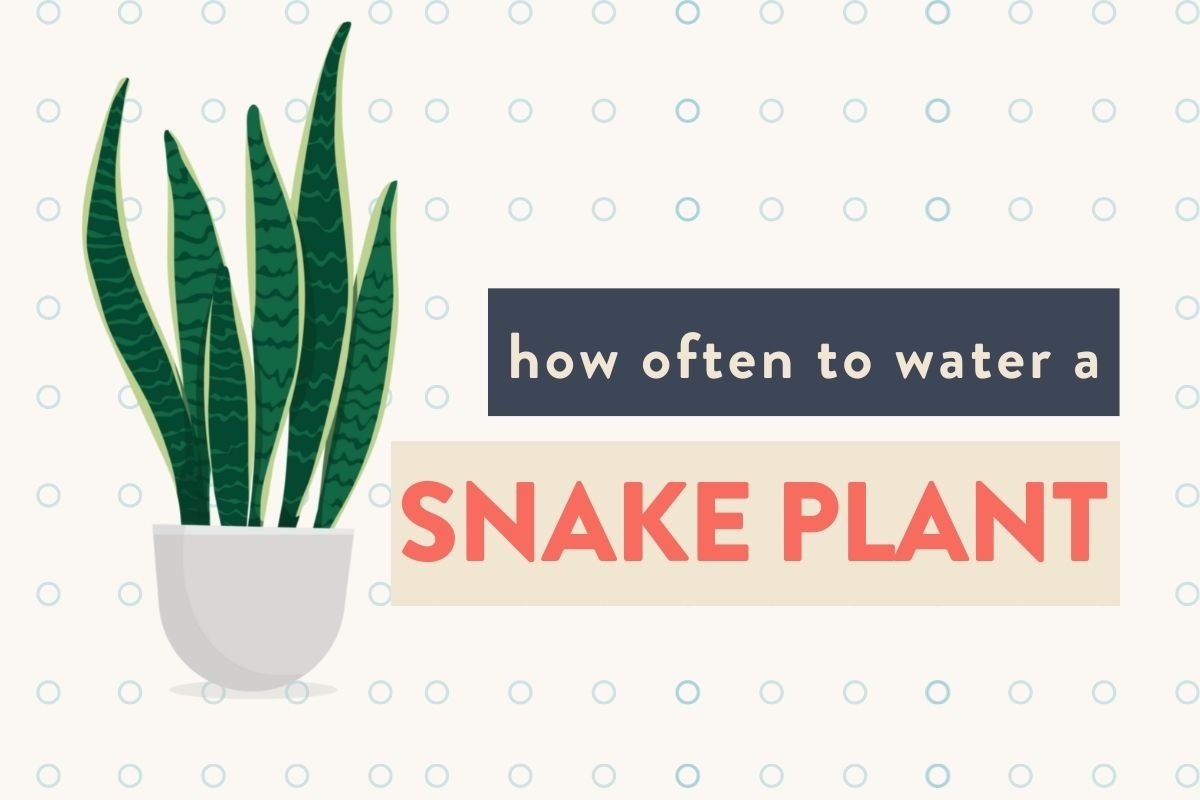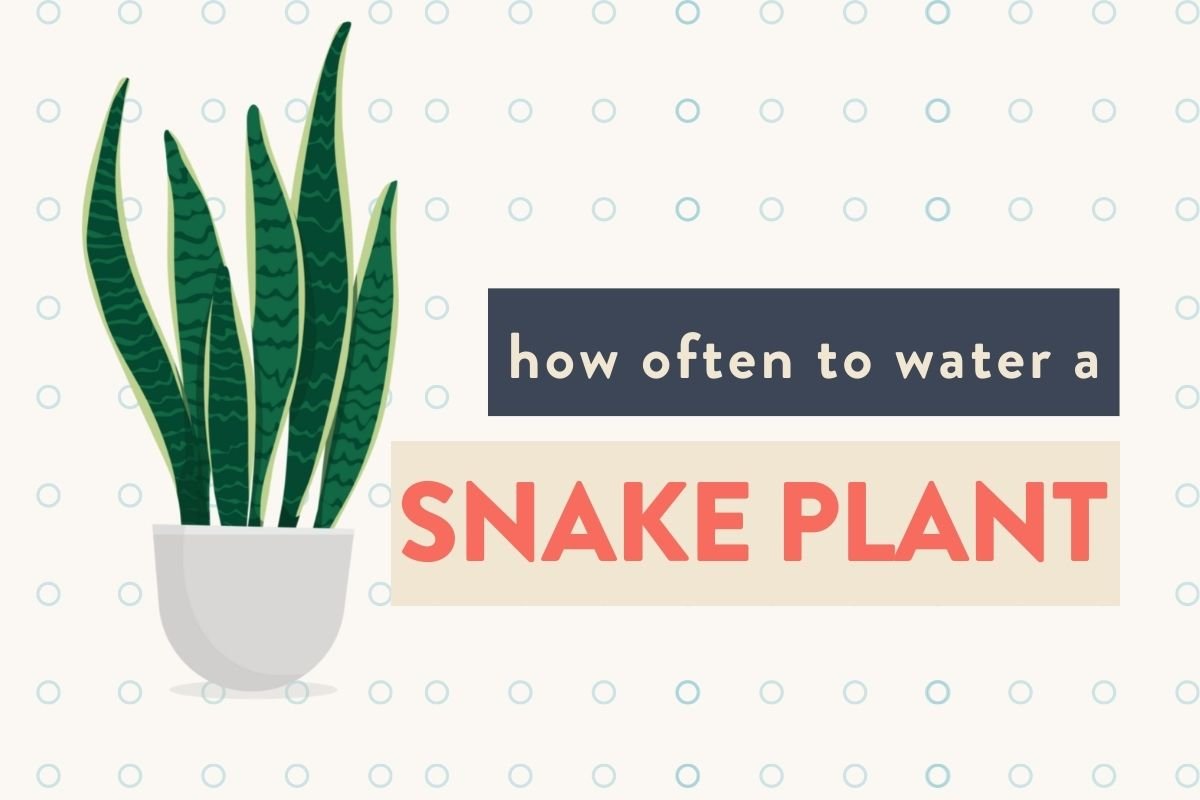How Often to Water Snake Plants in High-Humidity Areas is a question that often arises for plant enthusiasts, particularly those living in humid climates. While snake plants are known for their resilience and drought tolerance, the increased moisture in the air can significantly impact their watering needs.
Understanding how humidity affects these hardy plants is crucial for maintaining their health and preventing common watering problems.
This guide delves into the intricacies of watering snake plants in high-humidity environments, providing insights into factors that influence watering frequency, proper watering techniques, and troubleshooting common issues. From identifying the signs of overwatering and underwatering to creating a humid environment conducive to healthy growth, this comprehensive resource empowers you to nurture your snake plants to their full potential.
Understanding Snake Plant Watering Needs
Snake plants, known for their resilience and adaptability, are popular houseplants. They thrive in a wide range of conditions, including low light and infrequent watering. However, their watering needs can vary depending on factors like humidity levels.
The Influence of High Humidity on Watering Frequency
High humidity can significantly affect the watering frequency of snake plants. When the air is humid, the soil takes longer to dry out. This is because the moisture in the air is absorbed by the plant’s leaves, reducing the need for frequent watering.
Signs of Overwatering and Underwatering, How Often to Water Snake Plants in High-Humidity Areas
Recognizing the signs of overwatering and underwatering is crucial for maintaining the health of your snake plant. Overwatering is a common issue, especially in high-humidity environments.
Signs of Overwatering
- Yellowing leaves: Overwatering can lead to yellowing leaves, as the roots become suffocated by excess moisture.
- Soft, mushy leaves: Overwatering can cause the leaves to become soft and mushy, indicating root rot.
- Foul odor from the soil: A foul odor from the soil is a sign of bacterial or fungal growth, which can occur due to overwatering.
Signs of Underwatering
- Wilting leaves: Underwatered snake plants will exhibit wilting leaves, which may become limp and droopy.
- Dry soil: The soil will be dry to the touch, indicating a lack of moisture.
- Brown, crispy leaf tips: Underwatering can cause the leaf tips to turn brown and crispy.
Factors Influencing Watering Frequency
While understanding the general watering needs of snake plants is crucial, it’s equally important to consider specific factors that can influence how often you should water them in high-humidity environments. These factors can vary depending on your plant’s environment and its individual characteristics.
Pot Size
The size of the pot directly impacts how quickly the soil dries out. Smaller pots have a smaller volume of soil, which means they dry out faster than larger pots. This is because the surface area of the soil exposed to air is larger in smaller pots, leading to increased evaporation.
While snake plants are known for their drought tolerance, high-humidity areas can actually necessitate more frequent watering. The key is to ensure the soil dries out somewhat between waterings, as overwatering can lead to root rot. Choosing the right pot, like a bonsai pot, can play a crucial role in managing moisture levels.
Bonsai Pots: A Complete Guide to Picking the Right Style offers insights into selecting pots with proper drainage, which can be especially beneficial in humid environments. With the right pot and watering practices, your snake plant will thrive even in high humidity.
In high-humidity areas, the increased moisture in the air can further accelerate the drying process in smaller pots. Therefore, snake plants in smaller pots may need to be watered more frequently than those in larger pots.
Soil Type
The type of soil used for your snake plant plays a significant role in determining its watering needs. Different soil types have varying water retention capabilities.
- Well-draining soil, like a mixture of potting soil, perlite, and sand, allows excess water to drain quickly, preventing root rot. Snake plants in well-draining soil might require more frequent watering in high-humidity areas because the soil dries out faster.
- Heavy, dense soil, such as clay-based potting mixes, holds moisture for longer periods. Snake plants in such soil might need watering less frequently in high-humidity areas because the soil takes longer to dry out.
Plant Size
Larger snake plants have a greater root system, which can absorb and retain more water. As a result, they may require less frequent watering compared to smaller plants. This is because larger plants have a larger surface area for water absorption, allowing them to hold more moisture.
However, it’s important to note that even large snake plants in high-humidity areas might still need watering more frequently than their counterparts in drier climates. The increased humidity can create a more humid environment around the plant, leading to faster evaporation and a greater need for watering.
While snake plants are known for their drought tolerance, high-humidity environments can affect their watering needs. Understanding the true water requirements of these resilient plants is key to keeping them thriving. To determine how often to water your snake plant in humid conditions, it’s essential to consider factors like the size of the pot, the type of soil, and the plant’s overall health.
For a deeper dive into the nuances of snake plant watering, check out this informative article: How Much Water Does Your Snake Plant Actually Need?. Armed with this knowledge, you’ll be able to adjust your watering schedule accordingly and ensure your snake plant continues to flourish in even the most humid environments.
Temperature
Temperature significantly affects the rate of evaporation, which directly impacts how often you should water your snake plants. Warmer temperatures lead to faster evaporation, requiring more frequent watering.
In high-humidity areas, the combination of warm temperatures and high humidity can create a very humid environment around the snake plant, accelerating the drying process. This means that snake plants in warm, high-humidity environments may need to be watered more frequently than those in cooler, drier environments.
Light Conditions
The amount of light your snake plant receives can also affect its watering needs. Snake plants thrive in bright, indirect light. However, excessive direct sunlight can stress the plant and increase its water requirements.
In high-humidity areas, the combination of bright light and high humidity can lead to increased evaporation and a greater need for watering. Snake plants in bright, high-humidity environments may need to be watered more frequently than those in low-light, drier environments.
Seasonal Changes
The seasons can influence your snake plant’s watering needs, particularly in high-humidity areas. During the warmer months, when temperatures are higher and the air is more humid, snake plants may require more frequent watering.
Conversely, during the cooler months, when temperatures are lower and the air is less humid, snake plants may require less frequent watering.
Watering Techniques

Watering snake plants in high-humidity areas requires a slightly different approach than in drier climates. The increased moisture in the air can lead to slower drying times for the soil, potentially increasing the risk of root rot. This section will Artikel the best practices for watering snake plants in these environments.
Allowing Soil to Dry Out Between Waterings
It is crucial to allow the soil to dry out completely between waterings, even in high-humidity areas. This ensures that the roots have ample time to absorb the water and that the soil doesn’t become overly saturated.
Allowing the soil to dry out completely between waterings is a key principle in snake plant care, even in humid environments.
To determine if the soil is dry, you can use a finger test. Insert your finger about 1-2 inches into the soil. If it feels dry, it’s time to water.
Using a Moisture Meter
A moisture meter is a helpful tool for gauging the moisture level of the soil. It can provide a more accurate reading than the finger test, especially for larger pots.
A moisture meter can be a valuable tool in determining the precise moisture levels of the soil.
Insert the moisture meter probe into the soil and follow the instructions provided by the manufacturer. The meter will indicate the moisture level, which will help you decide whether or not to water.
Watering Techniques
- Thoroughly Water:When watering, apply enough water to saturate the entire root ball. This means allowing water to drain out of the drainage holes at the bottom of the pot. Avoid letting the plant sit in standing water, as this can lead to root rot.
- Water Deeply:Deep watering is essential for snake plants, as it encourages the roots to grow deeper into the soil. This also helps to ensure that the entire root ball is properly hydrated.
- Frequency:The frequency of watering will depend on the specific conditions of your environment. In high-humidity areas, snake plants may only need to be watered once every two to three weeks. However, it’s important to monitor the soil moisture and adjust the watering schedule accordingly.
Maintaining Optimal Humidity

While snake plants are known for their drought tolerance, they still thrive in a slightly humid environment. A humid environment mimics their natural habitat and can contribute to their overall health and vigor.
Ideal Humidity Levels
Snake plants generally prefer humidity levels between 40% and 60%. This range allows them to absorb moisture efficiently through their leaves, promoting healthy growth.
Creating a Humid Environment
- Using a Humidifier:A humidifier is the most effective way to increase humidity in a room. You can use a cool-mist humidifier to add moisture without disturbing the plant’s leaves. Place the humidifier a few feet away from the snake plant to ensure even moisture distribution.
- Grouping Plants Together:Plants naturally release moisture through transpiration, a process where water evaporates from their leaves. Grouping multiple plants together can create a microclimate with higher humidity levels.
- Pebble Tray:Place a tray filled with pebbles and water near the snake plant. As the water evaporates, it increases the humidity around the plant.
Monitoring Humidity Levels
- Humidity Meter:A humidity meter provides accurate readings of the relative humidity in the room. You can use this to monitor the humidity levels and adjust your watering accordingly.
- Observing the Plant:If the leaves are starting to dry out or appear wilted, it could indicate low humidity.
Troubleshooting Watering Issues
Even with careful watering practices, snake plants can sometimes experience problems. Recognizing the signs of overwatering or underwatering is crucial for maintaining their health. This section will provide solutions for common watering issues in snake plants, including yellowing leaves, root rot, and stunted growth.
Identifying Watering Problems
Understanding the symptoms of overwatering and underwatering is key to diagnosing and addressing watering issues. Here’s a table summarizing the common signs of each:
Symptom |
Overwatering |
Underwatering |
|---|---|---|
Leaf Color |
Yellowing, browning, or wilting leaves |
Leaves may turn brown or crispy at the tips |
Leaf Texture |
Leaves may feel soft or mushy |
Leaves become dry and brittle |
Root System |
Roots may become soft, mushy, and brown, indicating rot |
Roots may become dry and brittle |
Soil Condition |
Soil remains constantly wet and may smell musty |
Soil becomes dry and crumbly |
Growth Rate |
Stunted growth or no new growth |
Stunted growth or no new growth |
Addressing Overwatering
Overwatering is a common problem for snake plants, especially in high-humidity environments. Here’s how to address overwatering:
- Repotting:If the soil remains constantly wet and the roots are showing signs of rot, repotting is necessary. Use a well-draining potting mix and a pot with drainage holes. Carefully remove the plant from the pot, gently loosen the soil, and trim away any rotted roots.
Repot the plant in fresh potting mix, ensuring the crown (where the leaves emerge from) is above the soil line.
- Allowing the Soil to Dry:After repotting or if the soil is consistently wet, allow the soil to dry out completely between waterings. This can take several days or even weeks, depending on the humidity and temperature.
- Improving Drainage:Ensure the pot has drainage holes and that the soil mix is well-draining. Consider adding perlite or pumice to the potting mix to improve aeration and drainage.
Addressing Underwatering
While less common, underwatering can also affect snake plants. Here’s how to address underwatering:
- Thorough Watering:Water the plant thoroughly until water drains out of the drainage holes. Allow the excess water to drain completely before returning the plant to its saucer.
- Frequency Adjustment:Increase the frequency of watering based on the soil dryness and the plant’s needs.
- Checking Soil Moisture:Use a moisture meter or your finger to check the soil moisture before watering.
Preventing Future Watering Problems
By following these tips, you can prevent future watering issues and maintain the health of your snake plant:
- Choose the Right Pot:Use a pot with drainage holes to allow excess water to escape. Avoid using pots that are too large, as this can lead to overwatering.
- Use a Well-Draining Potting Mix:A well-draining potting mix allows excess water to drain quickly, preventing root rot.
- Monitor Soil Moisture:Regularly check the soil moisture before watering.
- Adjust Watering Frequency:Adjust the watering frequency based on the humidity levels, temperature, and the plant’s growth stage.
Final Summary

Successfully navigating the complexities of watering snake plants in high-humidity areas requires a balance of understanding, observation, and adaptation. By considering factors such as pot size, soil type, and light conditions, and by diligently monitoring your plant’s health, you can establish a watering routine that promotes optimal growth and prevents common problems.
Remember, every plant is unique, and what works for one may not work for another. Embrace the learning process, observe your snake plants closely, and adjust your watering practices accordingly to ensure their thriving in your humid environment.
FAQ Overview: How Often To Water Snake Plants In High-Humidity Areas
How can I tell if my snake plant is overwatered?
Overwatered snake plants often exhibit yellowing leaves, mushy roots, and a foul odor emanating from the soil. You may also notice the leaves becoming soft or drooping.
What are the signs of underwatering in snake plants?
Underwatered snake plants typically have dry, crispy leaves that may curl or wilt. The soil will feel very dry to the touch, and the plant may appear stunted or lackluster.
Can I use tap water to water my snake plant?
While tap water is generally suitable for snake plants, it’s best to let it sit for 24 hours to allow chlorine and other chemicals to evaporate. Alternatively, use filtered or bottled water.
How often should I fertilize my snake plant?
Fertilize your snake plant once a month during the growing season (spring and summer) with a balanced liquid fertilizer diluted to half strength.
